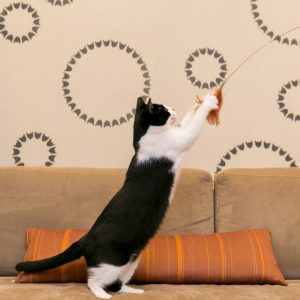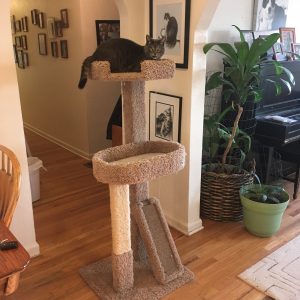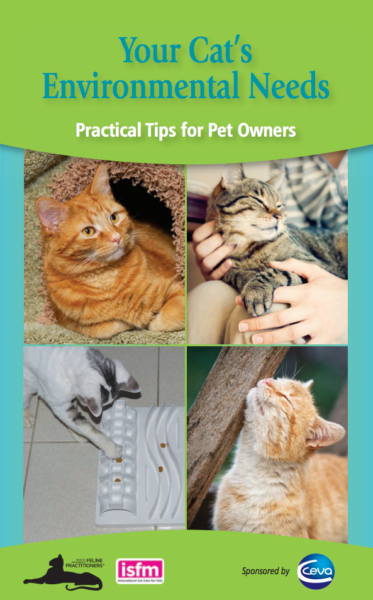Most people love watching their cat stalk, pounce, and play. Cats are highly intelligent, naturally curious, and active creatures. We need to make sure to provide them with plenty of mental and physical stimulation. Your cat needs to be able to hunt, stalk, and act out his natural, instinctive behaviors. Provide him with appropriate resources so he can play, engage in natural predatory behaviors, and have control over his social interactions.

Suggestions for Cat Friendly Play
Try to have a wide variety of toys and items that simulate or mimic the ‘prey’ cats naturally hunt (e.g., mice). Toys that have erratic movements and simulate or mimic the movements of prey are very exciting to cats. You should rotate and change your cat’s toys on a routine basis to keep him interested. Some cats become bored with a toy after a few days, some a few weeks, and some prefer only one toy. Also, allow your cat to capture the ‘prey’ at the end of his hunt/play session to satisfy his natural hunting instinct. This also prevents your cat from becoming frustrated. While lasers are very attractive to most cats, they don’t allow your cat to feel the sense of accomplishment of capturing the prey.
TIP: If you use a laser, hide a treat or piece of kibble. Then at the end, let your cat capture the laser where the treat is hidden. This way he feels like he captured the prey and is rewarded.
Cats tend to play more when they are hungry. So, manage his weight, feed him frequent small meals, or even hide food around the house to help encourage him to play more often. Offer dry food in food puzzles to entice your cat. This type of feeding simulates hunting and can aid weight loss in the overweight cat. It is important to have toys and enrichment items (i.e., cat trees, perches, windows to watch outdoor activity) available for your cat to play by himself when you are not home. You can also create do-it-yourself cat toys made out of common household items (i.e., paper towel rolls, boxes, socks, cardboard, crumpled paper, water bottles, etc.).
When your cat walks away from you, he is done playing. Do not force interaction, instead let him initiate, choose, and control the type of human contact he desires. Each cat has their own individual preference regarding how much human interaction they prefer.

Helpful Tips
Try to encourage your cat to play by using interactive toys that mimic prey, such as a toy mouse. You can pull the toy across a floor or wave a feather wand through the air. Remember not to use string-type products when playing with your cat. String, yarn, and similar types of products (i.e., rubber bands, tinsel, ribbon, streamers, etc.) are easily swallowed and cause very serious intestinal issues requiring surgery. If the toys or products have loose pieces (i.e., bells, googly eyes, small pieces, etc.) or string-type materials that your cat can swallow, put them away after playtime. Many household items and children’s toys can contain these types of materials. It is important to monitor all items brought into your home and put away anything that can be dangerous for your cat.
Introduce interactive play early in your cat’s life so he can learn how to play with you. Be careful to never use your hands or feet as toys during play. Although it may seem cute with kittens, as your kitten grows into a cat, he will believe this is an appropriate form of play. Scratching or biting can lead to painful injuries and infections. Instead, use food puzzles or food balls to mimic the action of hunting for prey, and provide a more natural eating behavior. It can also help your cat eat more slowly as he needs to work for her food. Reward your cat with treats to provide positive reinforcement.
If you have more than one cat, remember to play with each one individually. Teach children and those unfamiliar with cats how to play appropriately with your cats. This will help prevent your cats from becoming frustrated or scared. Play also provides your cat with much needed exercise. Exercise is critical in maintaining a healthy body weight and preventing your cat from becoming overweight or obese.
Building a Cat-Friendly Environment
Cats need a place to retreat for privacy and to feel safe, so make sure your cat has lots of safe areas to retreat and hide. Tall-sided or igloo cat beds and cardboard boxes are good options. Cats also love elevated perches or cat trees so they can observe, feel safe, and well – feel superior. Your cat needs areas to act out his normal scratching behavior. So, be sure to include scratching areas in your home where he can sharpen his nails and stretch his muscles.
Be sure you place your cat’s litter boxes where he can easily access them without any challenges or potential threats. Place his food and water in a separate area where he can eat and drink without stress. In general, the more cats you have in a household the more perches, hiding areas, and feeding/drinking areas you’ll need so each cat can feel independent and comfortable in their home domain!
Contributed by Dr. Ken Lambrecht, DVM


